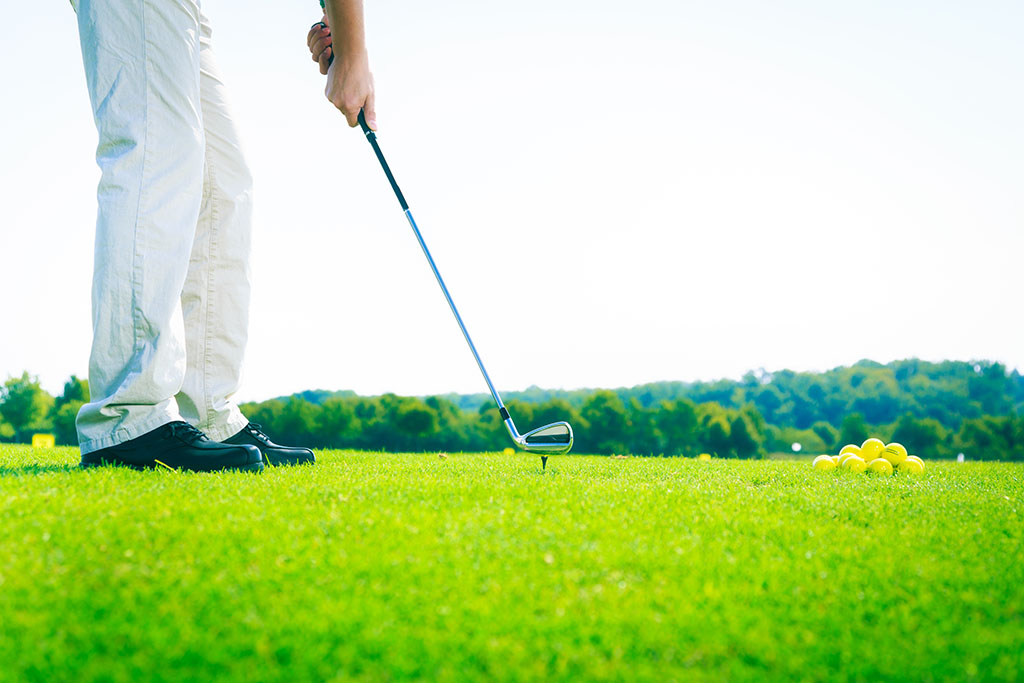
Fresh air, beautiful locations, physical and mental benefits – it’s easy to see why golf is one of the most popular sports in the UK, with nearly 2000 golf courses to choose from. Whether you’re just getting started and are overwhelmed with all the advice out there, or you’ve been around the course a few times and want to take your game to the next level and improve your score, perfecting your golf swing is vital.
While everyone has their own unique swing, making a few small adjustments can make a big difference and getting the basics right at the start can affect the rest of your game. So, let’s break it down.
Before The Swing
A: Perfecting your grip
Before you even start the swing, your hands need to be right; your hands are the only part of you that come into contact with the club and getting this right can solve a lot of other issues further down the line. There are three grip styles, weak, neutral and strong but a neutral grip is better for beginners, once you’ve mastered that you can adapt it by either tightening it or loosening it.
A common mistake it to hold the club in the palms, it needs to be in the fingers of your left hand (for right-handed players). Your index finger and thumb make a V shape that should point towards your right shoulder. The right palm then goes over the left thumb and again, most of the grip should be with the fingers. All the fingers on your right hand, apart from your little finger, should be touching the grip. Your thumbs should sit naturally on the club just to the left of the centre.
B: Correcting your aim
In a game that’s all about hitting a target, aim is very important. Imagine a line leading from the ball to the target, the line of your feet should be parallel to this line. This means that if you were to lay a stick along the back of your heels it would be parallel to the line from the ball to the target, like a train track. Make sure your shoulders and hips are also parallel to this line.
Often it helps to choose a spot closer to the ball, maybe some dirt on the ground, or a patch of grass that’s in line with the ball and your target. Make this the point you’re aiming for.
C: Adopting the right stance
A good golf stance helps your body get into the right position to take a great shot. It helps to keep you stable while you rotate and move into the swing without losing your balance. Your feet need to be shoulder width apart with a slight bend in the knees. Keep your back straight and tilt at the hips, keeping your arms loose. Remember to relax and keep your shoulders down which will help release any tension as this will affect your swing.

Taking Your Swing
A: The backswing
This is the action that brings the club up to the top of the swing. There’s no need to rush this, it sets you up for a good downswing so doesn’t need to be a fast movement. Check your elbows at this point, the left elbow needs to be straight; you’re not hitting a baseball and you need to keep your left heel on the ground. You need a soft bend in the right knee while the left knee points at the ball as your hips rotate, with most of your weight on your right foot. If you picture yourself standing in front of a big clock face, at the top of the backswing the club should be between the 1 and 3 o clock position.
B: The downswing
This is where you make contact with the ball. You need to lead with your hips and legs, then follow with your arms and torso. Keep your weight on the left foot and remember to keep the elbows in close to your body. This helps keep the power and guide your hands. You’ll know if you’ve got the positioning right because you’ll feel the pressure on your right index finger.
C: Striking the ball
By the point of impact your hips should be facing the target (belt buckle to target is a common term in golf) with your chest over the golf ball and the club face hitting the ball square, you’re not trying to get under it and lift it. It helps to keep your back straight and your head down, however tempting it is to watch where the ball is headed at this point and keep your lead hand away from your body. Try not to think of it as hitting the ball but swinging through – the club doesn’t stop when it gets to the ball.
D: Finishing the swing
The ‘finish’ of the swing starts when you’ve hit the ball and your arms are fully extended. When you’ve completed your follow-through, most of your weight should be on your front leg with your back heel raised. Your hips and chest should still be facing the target. You’ll end up looking like you’re resting your club on your left shoulder with it falling somewhere down your back. Golfers often hold this position for a few seconds; this isn’t just to pose (well, maybe sometimes); you need to hold this position as it trains your body to start and finish in the same position. It takes good balance to hold this.

Tips For A Better Swing
A: Improving your grip
A common problem with grip is holding the club too tightly, which creates tension that can affect the swing. In your lead hand, it’s the last three fingers that should be gripping the firmest.
B: Controlling direction
If you’re struggling with accuracy, you might want to try adjusting your grip. Once you’ve mastered the neutral grip you can make small changes that can help control direction. Draw and fade shots (a draw shot goes from right to left, a fade shot the opposite) affect the direction the ball travels in, and you may find that your natural swing already favours one of these, but try aiming the back of your left hand to the left of the target to draw the ball or to the right to fade the ball.
C: Hitting down on iron shots
One of the most rewarding shots to make is the perfect iron shot, but this isn’t easy. A common misconception with new golfers is that to send the ball far you have to hit under it and lift it, but the key to getting this shot right is to hit the back of the ball with the centre of the clubface, the ‘sweet spot’. Beginners could try practising with a short, lofted club to help develop the right posture, but it takes practice and a certain amount of instinct.
D: Improving your tempo
Good tempo, timing and balance are all crucial when it comes to perfecting your golf swing and one of the most common problems is swinging the golf club too fast in an attempt to generate sufficient power. A proper tempo needs to be slower on the backswing and faster on the downswing. You could try counting; the 1-2-3 waltz count helps, with 1-2 on the backswing, 3 on the downswing. You could also try singing a song with the right tempo while you’re practising, though again, in your head might be more socially acceptable!
E: Aim for a larger target
Aiming is straightforward, right? You just look at where you want the ball to go and aim for it. But it’s not always that easy and not getting the basics right can affect your performance; if you’re not aligned correctly things can easily go wrong. Set the clubface first, then your feet and shoulders, and try aiming for a larger area instead of focusing on the pin. It’s better to make par instead of a birdie.
F: Keep your eye on the ball
This is a bit of a sporting cliché, but it does actually help to focus on the part of the ball you want to hit, in this case, the back of the ball. It’s useful for hand-eye coordination and helps you rotate through the swing. If you struggle with this, you could try focusing on one particular dimple in the golf ball.

No two golfers play the same game; everyone has a different body type, shape, age and level of fitness, so the main thing to remember is to relax and then find your natural swing and work on improving that. You could try practising in front of a mirror or patio door or even getting someone to film you so you can see what you need to work on. Build your swing from the ground up and focus on your stance, set up and posture.
Hopefully, these tips have inspired you to head out for a game, but don’t forget to insure your golf clubs so that you can carry on improving your game, and maybe even give Tiger Woods a run for his money, knowing you have the right level of cover.
And if you’re feeling lucky then why not take part in one of our golf *prize giveaways that are taking place over the next few months. All you need to do is follow The Insurance Emporium Facebook page, like the posts and comment or tag your friends so that they can join in too. Keep an eye out for our prize draw posts, each with a unique and exciting prize.
* The prize draw is open to UK residents aged 18 years and over. See here for terms and conditions. Please note the closing dates.
All content provided on this blog is for informational purposes only. We make no representations as to the accuracy or completeness of any information on this site or found by following any link on this site. We will not be liable for any errors or omissions in this information nor for the availability of this information. We will not be liable for any loss, injury, or damage arising from the display or use of this information. This policy is subject to change at any time.
We offer a variety of cover levels, so please check the policy cover suits your needs before purchasing. For your protection, please ensure you read the Insurance Product Information Document (IPID) and policy wording, for information on policy exclusions and limitations.


